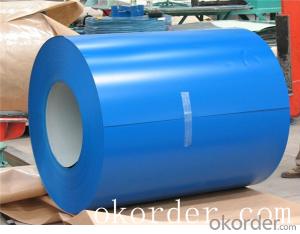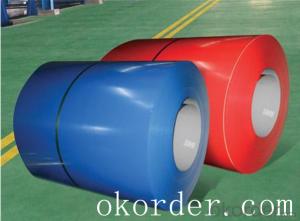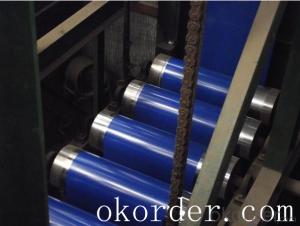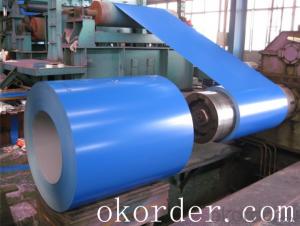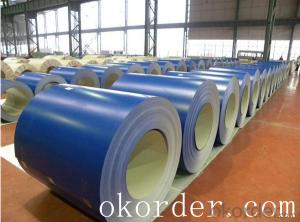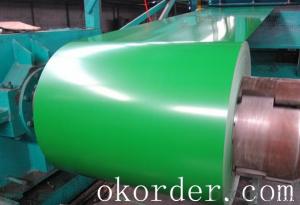Prime quality prepainted galvanized steel 610mm
- Loading Port:
- Tianjin
- Payment Terms:
- TT OR LC
- Min Order Qty:
- 100 m.t.
- Supply Capability:
- 10000 m.t./month
OKorder Service Pledge
OKorder Financial Service
You Might Also Like
Construction building material galvanized color prepainted cold
rolled steel coil
Prepainted steel sheet is coated with organic layer, which provides higher anti-corrosion property and
a longer lifespan than that of galvanized steel sheets.
The base metals for prepainted steel sheet consist of cold-rolled, HDG electro-galvanized and hot-dip
Alu-zinc coated. The finish coats of prepainted steel sheets can be classified into groups as follows:
polyester, silicon modified polyesters, polyvinylidene fluoride, high-durability polyester, etc
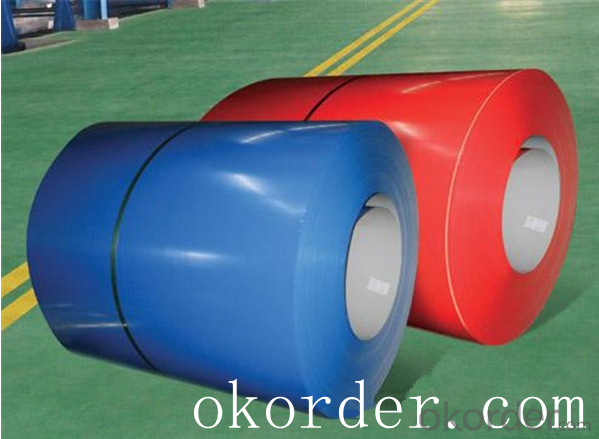
Standard and Grade :
Pre-paint galvanized steel coil | ||||
ASTM A755M-03 | EN10169:2006 | JISG 3312-2012 | ||
Commercial quality | CS | DX51D+Z | CGCC | |
Structure steel | SS GRADE 230 | S220GD+Z | CGC340 | |
SS GRADE 255 | S250GD+Z | CGC400 | ||
SS GRADE 275 | S280GD+Z | CGC440 | ||
SS GRADE 340 | S320GD+Z | CGC490 | ||
SS GRADE550 | S350GD+Z | CGC570 | ||
S550GD+Z | ||||
Application:
Outdoor | Roof, roof structure, surface sheet of balcony, frame of window, door of garage, rolled shutter door, booth, Persian blinds, cabana, etc |
Indoor | Door, isolater, frame of door, light steel structure of house, home electronic appliances, ect. |
- Q:How are steel billets marked for identification?
- Steel billets are typically marked for identification using a variety of methods such as stamping, engraving, or laser marking. This allows for important information like the grade, size, and batch number to be permanently etched onto the surface of the billet, ensuring easy identification and traceability throughout the manufacturing process.
- Q:What are the common applications of steel billets?
- Steel billets are semi-finished products that are used in various industrial applications. Some of the common applications of steel billets are: 1. Construction: Steel billets are widely used in the construction industry for structural purposes. They are used to manufacture beams, columns, and other load-bearing components in buildings, bridges, and other structures. The high strength and durability of steel billets make them ideal for withstanding heavy loads and providing structural integrity. 2. Automotive Industry: Steel billets are extensively used in the automotive industry for manufacturing various components such as crankshafts, camshafts, connecting rods, and gears. The excellent mechanical properties of steel billets ensure the reliability and performance of these critical automotive parts. 3. Machinery and Equipment Manufacturing: Steel billets are used in the production of machinery and equipment. They are utilized for manufacturing parts like gears, shafts, valves, and hydraulic cylinders. The versatility of steel billets allows for the customization of these components to meet specific operational requirements. 4. Electrical Industry: Steel billets find applications in the electrical industry for the production of electrical transformers and electric motor cores. The high magnetic permeability and electrical conductivity of steel make it an ideal material for these applications. 5. Pipe Manufacturing: Steel billets are commonly used in the manufacturing of pipes and tubes. They are processed through various techniques such as hot rolling, cold rolling, and extrusion to produce seamless or welded pipes. The strength and corrosion resistance of steel billets make them suitable for transporting fluids and gases in industries like oil and gas, water supply, and construction. 6. Shipbuilding: Steel billets are crucial in shipbuilding due to their strength, durability, and resistance to corrosion. They are used to manufacture various ship components such as hulls, frames, and bulkheads. The ability of steel billets to withstand harsh marine environments makes them an ideal choice for constructing ships and offshore structures. Overall, steel billets are versatile materials that find applications in a wide range of industries, thanks to their excellent mechanical properties, durability, and ability to be customized to meet specific requirements.
- Q:What are the specifications for tool steel billets used in the automotive industry?
- Tool steel billets used in the automotive industry must meet specific criteria to ensure their suitability for various applications. These criteria are essential to guarantee the desired performance and durability of the tool steel in automotive manufacturing processes. One crucial criterion for tool steel billets used in the automotive industry is their chemical composition. The tool steel needs to have a precise composition of elements like carbon, chromium, vanadium, and molybdenum, among others. These elements contribute to the steel's hardness, wear resistance, and toughness, which are vital properties for automotive tooling. Furthermore, the tool steel billets must fall within a specific range of hardness. Hardness can be measured using scales such as Rockwell or Brinell, and the desired level of hardness depends on the intended application. Tools that require high wear resistance generally prefer higher hardness, while tools that require toughness and impact resistance may tolerate lower hardness. Additionally, the tool steel billets used in the automotive industry must display excellent dimensional stability. This means that the steel should undergo minimal dimensional changes during heat treatment and manufacturing processes, ensuring that the tools maintain their shape and accuracy over time. Another important criterion is the machinability of the tool steel. It should be easy to machine and shape into the desired tooling components without excessive tool wear or difficulty. Good machinability allows for efficient production and reduces costs associated with tooling. Moreover, the tool steel billets used in the automotive industry should exhibit good thermal conductivity. This property enables the effective dissipation of heat generated during manufacturing processes like forging or heat treatment. Good thermal conductivity helps prevent localized overheating and ensures uniform heat distribution throughout the tool, resulting in consistent performance. Lastly, the tool steel billets should be free from defects and impurities that could compromise the integrity and performance of the tool steel. These defects include cracks, voids, inclusions, or any other imperfections. Typically, quality control measures such as non-destructive testing are implemented to ensure that the billets meet the required standards. In conclusion, the specifications for tool steel billets used in the automotive industry encompass factors such as chemical composition, hardness, dimensional stability, machinability, thermal conductivity, and overall quality. These specifications guarantee that the tool steel meets the specific requirements of automotive tooling applications, providing durability, performance, and reliability in automotive manufacturing processes.
- Q:How are steel billets rolled into shape?
- Steel billets undergo a process known as hot rolling to shape them. This involves heating the billets to high temperatures above 1,000 degrees Celsius to make them malleable and easier to shape. The heated billets are then passed through rolling mills, which consist of rotating cylindrical rollers. As the billets pass through the rollers, they are gradually compressed and elongated, resulting in the desired shape and size. The pressure applied by the rollers reduces the billets' thickness and increases their length. This continuous rolling process allows for precise control over the shape and dimensions of the steel product. To ensure smooth rolling and prevent the billets from sticking to the rollers, lubricants are commonly used. These lubricants also help dissipate the heat generated during rolling. Depending on the desired final product, the billets may undergo multiple passes through the rolling mills to achieve the desired shape and dimensions. After the initial rough rolling, further shaping and refining may be done through additional rolling stages. Once the desired shape is achieved, the steel is allowed to cool and solidify. This cooling process is crucial to ensure the final product possesses the desired mechanical properties and structural integrity. In summary, the hot rolling process of steel billets plays a vital role in the production of various steel products. It enables efficient shaping and forming of the billets into different shapes, sizes, and profiles, meeting the specific requirements of industries like construction, automotive, and manufacturing.
- Q:How are steel billets used in the manufacturing of kitchen appliances?
- Steel billets are used in the manufacturing of kitchen appliances as the primary raw material. These billets are heated and then shaped or molded into various components such as bodies, frames, handles, or cooktops, which form the structural foundation of kitchen appliances. The high strength and durability of steel make it an ideal choice for withstanding the rigors of everyday use in kitchen appliances, ensuring their longevity and quality.
- Q:What are the factors that affect the price of steel billets?
- The price of steel billets can be affected by several factors. 1. Raw material costs have a significant impact on the price of steel billets. Fluctuations in the cost of iron ore, coal, and other raw materials used in steel production directly influence the price of steel billets. 2. The supply and demand dynamics of steel billets play a crucial role in determining their price. An increase in demand for steel products, such as construction materials or automotive parts, can drive up the price of steel billets. Conversely, an oversupply can lead to a decrease in price. 3. Energy costs required for steel production can impact the price of steel billets. Fluctuations in energy prices affect the overall production cost and, subsequently, the price of steel billets. 4. Currency exchange rates can have a significant impact on the price of steel billets. If the currency of the country producing steel billets weakens against other currencies, it can make the product more affordable and potentially increase demand. 5. Government regulations, trade policies, and tariffs imposed on steel billets can influence their price. Tariffs can increase the cost of imported steel billets, making domestically produced steel billets relatively more competitive and potentially leading to higher prices. 6. The overall state of the economy, both locally and globally, can impact the price of steel billets. During periods of economic growth, there is typically higher demand for steel products, which can drive up the price. Conversely, during economic downturns, demand may decrease, resulting in lower prices. 7. Technological advancements in steel production can impact the price of steel billets. Innovations that increase efficiency and reduce production costs can potentially lead to lower prices, while new technologies that improve the quality or properties of steel billets may command a higher price. It is important to note that these factors are interconnected and can influence each other. Therefore, understanding the complex relationship between these factors is essential in analyzing and predicting the price of steel billets.
- Q:What are the different surface treatments for improved surface cleanliness in steel billets?
- There are several surface treatments available for improving surface cleanliness in steel billets. These treatments are designed to remove impurities, oxides, and contaminants from the surface of the billets, resulting in a cleaner and more uniform surface. One common surface treatment is pickling, which involves immersing the steel billets in an acid solution. The acid helps dissolve and remove any oxides or scale present on the surface of the billets. This process not only cleans the surface but also helps improve the adhesion of subsequent coatings or treatments. Another surface treatment option is shot blasting or abrasive blasting. This process involves propelling abrasive materials, such as steel shot or grit, at high speeds onto the surface of the billets. The impact of the abrasive particles removes any contaminants, rust, or scale, resulting in a cleaner surface. Shot blasting is an effective method for preparing the surface of steel billets for further processing or coating. Chemical cleaning is another surface treatment technique used to improve cleanliness in steel billets. This process involves using chemical agents to dissolve and remove contaminants from the surface. Different chemicals, such as alkaline or acid-based solutions, can be employed depending on the type and severity of the contaminants present. Chemical cleaning can be an effective method for removing stubborn contaminants or residues from the surface of the billets. Additionally, mechanical cleaning methods, such as wire brushing or grinding, can be used to improve surface cleanliness. These techniques involve physically removing contaminants or scale from the surface using mechanical means. Wire brushing uses wire bristles to scrub the surface, while grinding involves the use of abrasive materials to remove any imperfections or contaminants. Overall, the choice of surface treatment for improved cleanliness in steel billets depends on several factors, including the specific contaminants present, the desired level of cleanliness, and the intended application of the billets. It is essential to consider the effectiveness, cost, and environmental impact of each treatment method to select the most suitable option.
- Q:What are the different types of defects that can occur in steel billets?
- There are several types of defects that can occur in steel billets. These defects can occur during the manufacturing process or as a result of external factors. Some of the common types of defects include: 1. Surface defects: These defects occur on the outer surface of the billet and can include scratches, pits, scabs, scale, and cracks. Surface defects can be caused by handling, improper cooling, or contamination during manufacturing. 2. Internal defects: These defects occur within the body of the billet and are not visible on the surface. They can include voids, porosity, inclusions, and segregation. Internal defects can be caused by improper solidification, improper casting, or impurities in the steel. 3. Dimensional defects: These defects occur when the billet does not meet the desired dimensions or tolerances. Dimensional defects can include variations in length, width, thickness, or straightness. These defects can be caused by improper rolling, uneven cooling, or misalignment of the equipment. 4. Mechanical defects: These defects affect the mechanical properties of the steel billet. They can include improper grain structure, low hardness, brittleness, or poor toughness. Mechanical defects can occur due to improper heat treatment, incorrect alloy composition, or inadequate rolling processes. 5. Weld defects: In case of welded billets, defects related to the welding process can occur. These defects can include lack of fusion, incomplete penetration, porosity, or cracks in the weld zone. Weld defects can be caused by improper welding parameters, inadequate preparation, or contamination during the welding process. It is important to detect and address these defects to ensure the quality and integrity of the steel billets. Various inspection techniques such as visual inspection, ultrasonic testing, magnetic particle testing, or radiographic testing can be employed to identify and classify these defects.
- Q:How are steel billets used in the production of reinforcing bars?
- The production of reinforcing bars relies heavily on steel billets, a crucial element in the process. These billets, categorized as semi-finished steel products, act as the primary raw material. To facilitate the formation of reinforcing bars, the steel billets undergo heating within a furnace, reaching a specific temperature. This heating procedure serves to enhance the steel's malleability, making it more pliable and easier to mold. Once the desired temperature is achieved, the billets progress through a sequence of rolling mills. These mills exert substantial pressure on the billets, progressively reducing their size and shaping them into the necessary dimensions for reinforcing bars. Additionally, the rolling process enhances the steel's mechanical properties, augmenting its strength and durability. After the completion of the rolling process, the elongated steel bars are cut into precise lengths based on desired dimensions and requirements. Subsequently, these lengths are allowed to cool, promoting steel stabilization and averting any deformations. Ultimately, the reinforcing bars undergo a surface treatment process, such as hot-dip galvanization or epoxy coating. This treatment imparts corrosion resistance and extends the lifespan of the reinforcing bars. Consequently, the performance and durability of these bars are enhanced, rendering them suitable for utilization in construction projects. In conclusion, steel billets are indispensable in the initial phases of reinforcing bar production. By means of heating, rolling, cutting, and surface treatment processes, these billets are transformed into high-strength steel bars that reinforce concrete structures.
- Q:How do steel billets contribute to the manufacturing of medical equipment?
- The manufacturing of medical equipment is greatly aided by steel billets. Various components of medical equipment are produced using steel billets as the raw material. These billets are melted and then formed into tubes, rods, or sheets, which are subsequently utilized to create essential parts of medical equipment. For example, scalpels, forceps, and scissors, which require precision and durability, are commonly manufactured using steel billets. Steel's strength and resistance to corrosion make it the ideal material for these instruments. By melting and shaping steel billets into specific forms, the reliability and longevity of these instruments are ensured. Furthermore, medical implants such as hip replacements, knee replacements, and dental implants require materials that are biocompatible, strong, and resistant to wear. Steel billets, especially stainless steel, fulfill these requirements and are employed in the creation of implants that enhance the quality of life for many patients. In addition, steel billets contribute to the manufacturing of medical equipment by providing the framework for devices like hospital beds, surgical tables, and examination tables. These structures need to be sturdy, stable, and capable of supporting the weight of patients. Steel billets are transformed into various shapes and sizes to construct the frames and bases of these equipment, ensuring their robustness and reliability. To summarize, steel billets play a vital role in the manufacturing of medical equipment. They serve as the raw material, which is melted, shaped, and converted into components, instruments, and structures necessary for the production of surgical instruments, implants, and medical devices. The strength, durability, and corrosion resistance of steel make it an ideal material for manufacturing medical equipment that meets the stringent standards of the healthcare industry.
1. Manufacturer Overview |
|
|---|---|
| Location | |
| Year Established | |
| Annual Output Value | |
| Main Markets | |
| Company Certifications | |
2. Manufacturer Certificates |
|
|---|---|
| a) Certification Name | |
| Range | |
| Reference | |
| Validity Period | |
3. Manufacturer Capability |
|
|---|---|
| a)Trade Capacity | |
| Nearest Port | |
| Export Percentage | |
| No.of Employees in Trade Department | |
| Language Spoken: | |
| b)Factory Information | |
| Factory Size: | |
| No. of Production Lines | |
| Contract Manufacturing | |
| Product Price Range | |
Send your message to us
Prime quality prepainted galvanized steel 610mm
- Loading Port:
- Tianjin
- Payment Terms:
- TT OR LC
- Min Order Qty:
- 100 m.t.
- Supply Capability:
- 10000 m.t./month
OKorder Service Pledge
OKorder Financial Service
Similar products
New products
Hot products
Related keywords
